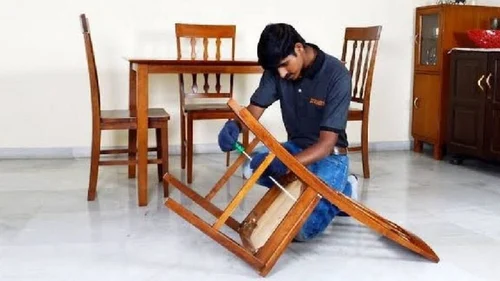As Michigan’s population ages, the importance of home accessibility, particularly through chair removal, becomes increasingly paramount. The demographic shift towards an older populace necessitates a comprehensive understanding of the challenges seniors face in navigating their living spaces. Chair removal emerges as a critical component in this endeavor, as it contributes to the creation of safer, more navigable environments for Michigan’s aging population. This introduction sets the stage for exploring the significance of home accessibility modifications, specifically focusing on chair removal, in addressing the evolving needs of seniors across Michigan. Through proactive measures and collaborative efforts, ensuring home accessibility becomes a vital aspect of supporting the well-being and independence of the state’s aging residents. Understanding the unique needs and challenges faced by Michigan’s aging population is essential in devising effective strategies to enhance home accessibility. With the proportion of seniors expected to double by 2050, there is a growing imperative to address mobility limitations and safety concerns within residential settings. Chair removal emerges as a practical solution to create more open and navigable spaces, mitigating the risk of falls and accidents. Furthermore, by promoting independence and enabling seniors to age comfortably in their homes, chair removal initiatives contribute to fostering a sense of dignity and autonomy among Michigan’s older adults. This description underscores the significance of prioritizing home accessibility efforts and underscores the importance of initiatives like chair removal in supporting the aging population.
Enhancing Home Accessibility for Michigan’s Aging Population through Chair Removal
Welcome to A&B Junk Removal, where we prioritize the safety and comfort of Michigan’s aging population through expert chair removal and home accessibility solutions.

Understanding the Impact: Aging Population Trends in Michigan
Michigan, like many states in the U.S., is experiencing a significant demographic shift with its aging population and chair removal services. As the Baby Boomer generation ages, the proportion of older adults in the state’s population is steadily increasing. According to recent census data, Michigan’s senior population is expected to double by 2050. This demographic trend has profound implications for various aspects of society, including healthcare, housing, and accessibility. Understanding the scale and nature of this demographic shift is crucial for policymakers, community organizations, and individuals alike to effectively address the evolving needs of older adults.
The Importance of Home Accessibility for Michigan’s Seniors
For many older adults in Michigan, their home is not just a place to live but also a sanctuary of comfort and familiarity. However, as individuals age, they may encounter mobility challenges that affect their ability to navigate and access different areas of their homes safely. Home accessibility modifications, such as chair removal and installing ramps or grab bars, play a vital role in enabling seniors to maintain independence and age in place. These modifications not only enhance safety but also promote physical and mental well-being by reducing the risk of accidents and falls. Recognizing the importance of home accessibility for Michigan’s seniors is essential for fostering a supportive environment that enables older adults to remain active members of their communities for as long as possible.
Challenges Faced: Chair Removal and Mobility Issues
Chair removal and addressing mobility issues pose significant challenges for Michigan’s aging population. Many older adults may struggle with limited mobility due to age-related conditions such as arthritis, muscle weakness, or neurological disorders. The presence of bulky furniture, including chairs, can exacerbate these challenges by obstructing pathways and hindering movement within the home. Moreover, the process of removing chairs or other furniture to create more accessible living spaces can be physically demanding and require careful planning to ensure the safety and comfort of the individual. Additionally, there may be emotional attachments to certain pieces of furniture, making the decision to remove them more difficult for both the individual and their family members. Overcoming these challenges requires a comprehensive approach that addresses not only the physical aspects of chair removal but also the emotional and practical considerations involved.
Legislation and Policies: Supporting Accessibility Initiatives in Michigan
Recognizing the importance of promoting home accessibility for seniors, Michigan has implemented legislation and policies aimed at supporting accessibility initiatives across the state. These initiatives may include tax incentives or funding programs to assist older adults with home modifications, including chair removal and other accessibility improvements. Additionally, there may be building codes or regulations in place to ensure that new construction or renovations adhere to accessibility standards, making homes more accommodating for individuals of all ages and abilities. By establishing supportive policies and regulations, Michigan demonstrates its commitment to enhancing the quality of life for its aging population and creating inclusive communities where everyone can thrive.
Assessing Home Accessibility Needs: Tools and Resources Available
To effectively address home accessibility needs, individuals and caregivers can utilize various tools and resources available in Michigan. These resources may include assessment checklists or guides designed to help identify potential barriers within the home environment. Professional assessments conducted by occupational therapists or certified aging-in-place specialists can also provide valuable insights into specific modifications needed to enhance accessibility and safety. Additionally, community organizations or local agencies may offer assistance programs or referrals to trusted contractors experienced in home modifications. By utilizing these tools and resources, individuals can make informed decisions about the necessary modifications to improve home accessibility and support aging in place.
Chair Removal: Strategies for Safe and Effective Home Modifications
Chair removal is a critical aspect of home modifications aimed at improving accessibility for seniors in Michigan. Strategies for safe and effective chair removal may involve careful planning and coordination with trained professionals or family members. This may include assessing the layout of the home to determine the best placement for chairs and other furniture, considering alternative seating options that provide better accessibility and comfort, and ensuring that pathways remain clear and unobstructed. Proper lifting techniques and the use of assistive devices may also be employed to minimize the risk of injury during the removal process. By implementing these strategies, individuals can create safer and more accessible living environments that promote independence and well-being for Michigan’s aging population.
Collaborative Efforts: Community Partnerships for Accessibility Solutions
Collaborative efforts between various stakeholders play a crucial role in addressing home accessibility challenges faced by Michigan’s aging population. Community partnerships bring together government agencies, non-profit organizations, healthcare providers, local businesses, and volunteers to collectively work towards enhancing accessibility initiatives. These partnerships can facilitate the sharing of resources, expertise, and best practices, allowing for more efficient and effective implementation of accessibility solutions. Community-based initiatives such as volunteer-led home modification programs or neighborhood accessibility committees can also provide valuable support to seniors in need of assistance with chair removal and other accessibility modifications. By fostering collaboration among diverse stakeholders, Michigan communities can create more inclusive environments where older adults can age comfortably and safely in their homes.
Technology Solutions: Innovations in Chair Removal and Home Accessibility
Technological advancements offer innovative solutions to address chair removal and home accessibility challenges faced by Michigan’s aging population. Smart home technologies, such as motorized lift systems or remote-controlled furniture, can assist individuals with mobility limitations in moving chairs and other furniture more easily within their homes. Additionally, wearable devices or smartphone applications equipped with motion sensors and fall detection capabilities can provide added safety and peace of mind for seniors living independently. Furthermore, virtual reality simulations or online platforms may be utilized to visualize and plan home modifications, allowing individuals to explore different design options before making decisions. By embracing technology-driven solutions, Michigan can leverage the power of innovation to enhance accessibility and improve the quality of life for its aging residents.
Financial Assistance Programs: Supporting Michigan Seniors in Accessibility Projects
Recognizing the financial burden associated with home accessibility modifications, Michigan offers various assistance programs to support seniors in undertaking chair removal and other accessibility projects. These programs may include grants, low-interest loans, or tax credits specifically aimed at funding home modifications for aging in place. Additionally, Medicaid waivers or long-term care insurance policies may cover certain accessibility expenses, depending on individual eligibility criteria. Local agencies on aging or community organizations may also provide information and assistance in accessing financial resources and navigating the application process. By alleviating financial barriers, these assistance programs enable more seniors to afford necessary home modifications and maintain independence in their living environments. Understanding safety precautions during chair removal is essential for protecting yourself and others, especially in the context of chair removal’s impact on home accessibility, particularly pertinent in Michigan’s aging population.

Empowering Independence: Enhancing Quality of Life Through Home Accessibility
Ultimately, the goal of chair removal and home accessibility initiatives in Michigan is to empower seniors to live independently and enhance their overall quality of life. By creating safe, comfortable, and accessible living environments, older adults can maintain their autonomy and dignity while aging in place. Accessible homes not only reduce the risk of accidents and injuries but also promote social engagement, emotional well-being, and continued participation in meaningful activities. Moreover, by supporting aging in place, Michigan communities benefit from the wisdom, experience, and contributions of their older residents, fostering intergenerational connections and enriching the fabric of society. Through concerted efforts to improve home accessibility, Michigan can ensure that seniors can age with grace and dignity in the comfort of their own homes.
FAQs
Why is chair removal important for home accessibility in Michigan?
Chair removal creates more open and navigable spaces, reducing the risk of falls and accidents for seniors with mobility issues. It facilitates easier movement within the home, promoting independence and improving overall safety.
How can I determine if chair removal is necessary in my home?
Assess your home’s layout and consider factors like narrow pathways or obstacles hindering mobility. Consult with professionals or use assessment tools to identify areas where chair removal may enhance accessibility.
What are some alternative seating options after chair removal?
Consider replacing chairs with mobility-friendly options like stools, benches, or adjustable-height seating. These alternatives provide comfort and support while maximizing space and accessibility within the home.
Are there financial assistance programs available for chair removal and home accessibility projects in Michigan?
Yes, Michigan offers various grants, loans, and tax credits to support home modifications for seniors. Contact local agencies on aging or community organizations for information on available financial assistance programs.
Can technology help with chair removal and home accessibility?
Yes, technology offers solutions like motorized lift systems and smart home devices to assist with chair removal and enhance overall accessibility. These innovations can improve convenience, safety, and independence for seniors in Michigan.
Conclusion
In addressing the home accessibility needs of Michigan’s aging population, chair removal emerges as a pivotal solution to enhance safety and mobility within residential spaces. By creating more open and navigable environments, chair removal not only reduces the risk of accidents and falls but also promotes independence and quality of life for seniors. Collaborative efforts between government agencies, community organizations, and technological innovations play crucial roles in facilitating chair removal initiatives and supporting aging in place. Through financial assistance programs and accessible resources, Michigan demonstrates its commitment to empowering seniors to age comfortably and securely in their homes, enriching communities and fostering inclusivity for all residents. Chair removal and home accessibility initiatives are vital components of ensuring the well-being and independence of Michigan’s aging population. By addressing mobility barriers within residential settings, such as narrow pathways or obstructed spaces, chair removal facilitates safer navigation and promotes a higher quality of life for seniors. These efforts are further bolstered by collaborative partnerships between governmental agencies, community organizations, and technological advancements, which collectively strive to support aging in place. With accessible resources and financial assistance programs available, Michigan demonstrates its dedication to fostering inclusive environments where seniors can age with dignity and autonomy in the comfort of their own homes. Through ongoing commitment and innovation, the state continues to pave the way towards a more accessible and supportive future for its aging residents.




